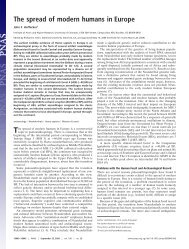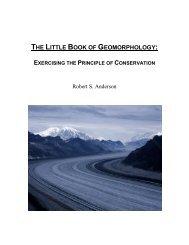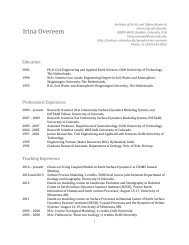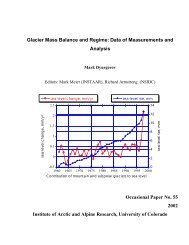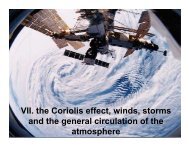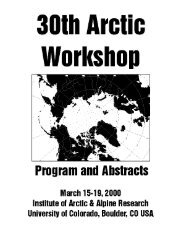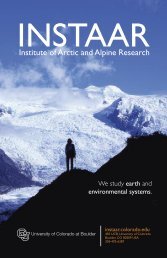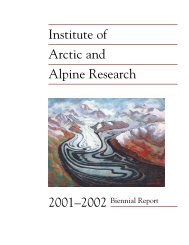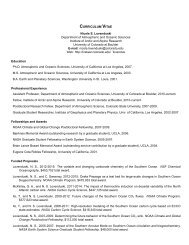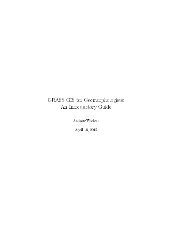00_cover_Biennial Report 05-06.qxd - INSTAAR - University of ...
00_cover_Biennial Report 05-06.qxd - INSTAAR - University of ...
00_cover_Biennial Report 05-06.qxd - INSTAAR - University of ...
- No tags were found...
Create successful ePaper yourself
Turn your PDF publications into a flip-book with our unique Google optimized e-Paper software.
Societal Outreach andInformal EducationOver the last two years, societal outreach and informaleducational opportunities have become a strong part<strong>of</strong> <strong>INSTAAR</strong>’s mission. The institute continues to presentits popular Open House annually. Undergraduate studentsare <strong>of</strong>ten mentored through hands-on research projects.Outreach is facilitated through the <strong>INSTAAR</strong> web site, andwith a variety <strong>of</strong> online initiatives for sharing and illustratingscientific information. On a day-to-day basis, <strong>INSTAAR</strong>members respond to inquiries from the public and themedia on a broad spectrum <strong>of</strong> scientific matters that relateto <strong>INSTAAR</strong>’s research. They regularly give lectures and presentationsto schools and civic groups and provide TV andradio interviews for the popular press.In May 2<strong>00</strong>5, <strong>INSTAAR</strong> continued its successful series<strong>of</strong> open houses by hosting 172 eighth-graders from SouthernHills Middle School. The energetic students collectedsamples and learned about relationships among streamflow, water quality, and insect ecology at nearby BoulderCreek. By visiting a few <strong>of</strong> the many labs at <strong>INSTAAR</strong> andthe National Snow and Ice Data Center (NSIDC), the studentslearned how materials such as bones and soils areradiocarbon dated, how climate controls the extent <strong>of</strong> glaciersand sea ice, and how past droughts are recorded intree rings. In addition to the hands-on exercises, studentslearned about early human migration into Europe and theevolution <strong>of</strong> the Bering Land Bridge. The open house helpedconvey diverse aspects <strong>of</strong> earth science, use <strong>of</strong> sophisticatedinstrumentation and modeling, and the relevance <strong>of</strong> earthscience for important global and local issues.In April <strong>of</strong> the following year, <strong>INSTAAR</strong> again hosted182 eighth-graders from Southern Hills Middle School.Similar to the past, the students were divided into groups toparticipate in lab tours, lectures, science games, and streamsampling activities. Students’ knowledge <strong>of</strong> snow and icewas tested during a fun quiz show run by staff <strong>of</strong> the adjacentNSIDC. They learned about ancient artifacts frommelting glaciers in Alaska. And they “flew” along a threedimensionalvirtual tour <strong>of</strong> the Arctic, illustrating key findingsfrom the Arctic Climate Impact Assessment.<strong>INSTAAR</strong> continued strong involvement with severalCU initiatives to directly involve undergraduates and minoritystudents in scientific research. These included theSummer Undergraduate Research Fellowship (SURF) program,the Summer Multicultural Access to Research Training(SMART) program, the Significant Opportunities inAtmospheric Research and Science (SOARS) program, andothers. For example, Detlev Helmig mentored seven studentswith research on volatile organic emissions, ozone,meteorology, and atmospheric toxins.Bill Bowman has taken the lead role for a ResearchExperiences for Undergraduates (REU) program at theMountain Research Station. The program has been fundedby the National Science Foundation since 1994, and wasjust renewed with funding through 2010. Students workone-on-one with faculty mentors on their own research topics.Forty percent <strong>of</strong> the REU alumni have gone on to graduateprograms, with another 20 percent working in researchsupport positions. Thirty percent <strong>of</strong> the participants arefrom under-represented groups, increasing the access <strong>of</strong>minority students to careers in biological research.Highlights for outreach to local schools include: Several <strong>INSTAAR</strong> scientists—including Cory Cleveland,Natalie Mladenov, Craig Lee, and Bill Manley—helped tointerview and mentor young students at the High PeaksElementary School Science Fair. Suzanne Anderson spoke to a junior elementary class atthe Jarrow Montessori school about glaciers and climatechange. Diana Nemergut taught a Microbial Diversity course atBoulder Preparatory High School. She and AlanTownsend serve as board members for this unique andhighly successful charter school, which requires collegeacceptance for graduation. Diane McKnight and Karen Cozzetto reviewed curriculumfor the McMurdo Dry Valleys Interactive CD Set forStudents and Teachers, developed by Carol Landis at theByrd Polar Research Center. One CD is designed forgrades 8–10 and illustrates the research and ecology <strong>of</strong>the Dry Valleys region <strong>of</strong> Antarctica. An accompanyingteachers’ guide contains supplemental information andvideos about the streams, lakes, glaciers, and soil biota <strong>of</strong>the Dry Valleys. Karen Cozzetto spoke with elementary students at aone-room schoolhouse in Jamestown, Colorado. She readfrom The Lost Seal book with slides to describe scientificresearch in the harsh environments <strong>of</strong> Antarctica.Diana Nemergut (<strong>INSTAAR</strong>,right) shows Boulder Prep HighSchool students how to platebacteria onto Petri dishes, February2<strong>00</strong>6. Photo: Lili Adeli(Boulder Prep).SOCIETAL MISSION | 33



